Abstract
The study raises the issue of the need to verify the adequacy of the skills forming the educational program to the current realities. The initial data consists of a sample of 20 skills divided into 5 groups. The common methods of evaluating study programs are considered and the presence of a human factor is noted. The authors proposed to evaluate the indicators of technology development based on the annual number of published patents and labor market data, as it is an objective approach that excludes human participation. The main difficulties leading to the occurrence of large amounts of false positive results were noted, which required the development of filtering mechanisms. The analysis of the skills was conducted using data on patent activity and the state of the labor market. Professional predictive learning service was involved in order to do this, which was improved in accordance with the requirements of the study. The results show that there is a high level of correlation between patent activity and subsequent demand for specific skills in the labor market (r = 0.8). Most of the skills are recommended for the study, 10 of them are well-established in the labor market, 9 more skills are promising and gaining popularity.
Keywords: Technology forecastingpatent analysiseducationtrainingcurriculum reviewpredictive learning
Introduction
While designing an educational program, the question always arises: which main technologies should be studied out of the available alternatives (Brusilovsky, et al., 2014). This is an important issue from the earliest days in education: for programmers, it is about which programming language is best suited to begin learning the profession, which version and which operating system is best fitted (Konecki & Petrlic, 2014). In the medical field, the number of saved lives can depend on the staff's experience with the most relevant skills (Neily, et al., 2010). Although, often this is determined by the existing hardware base, for example, it can be determined by the high-tech equipment for diagnosis in medical professions. It is impossible to teach functional magnetic resonance imaging without the equipment. Thus, the first issue, even for specialists in the field of education, is the choice of the best out of available options, for practical classes in the disciplines that will form the basis of the profession.
Currently there are a number of methods for assessing the relevance of training programs. One of them is the internal survey of the employees of the educational institution (Bird, van de Mortel, Holt, & Walo, 2015) in the format of a structured or unstructured interview, thereby attracting more experts to the issue. Indicators of achievements are considered for the assessment as well, for example, the level of employment among graduates (Crebert, Bates, Bell, Patrick, & Cragnolini, 2004).
Since many professions are tied to the development of technologies, the indicator of innovation in the areas of economic activity and the corresponding professions can be determined using methods of the patent activity analysis (Altuntas, Dereli, & Kusiak, 2015; Lee, Kim, Kwon, & Woo, 2016).
It is proposed to use this fact to update the educational programs of professional education and professional development.
Problem Statement
The authors of the article were tasked to assess the relevance of mastering the skills and technologies included in the educational program of professional education courses. The collection of expert assessments is the most common method for solving such a problem (Tynjälä, Slotte, Nieminen, Lonka, & Olkinuora, 2006). The authors propose to evaluate existing training programs based on patent activity related to the corresponding technologies as an objective estimate without human involvement (Hagiu & Yoffie, 2013).
According to the authors, it is correct to say that the set of skills determines the professionalism of a particular specialist at the specific time. For example, the most popular programmer in the labor market will be the one with a set of desired skills and knowledge of the required technologies, whether it be specific operating systems, programming languages or methodologies used. This makes it possible to call this programmer a professional and it is these skills that reflect the professional suitability. Obsolete programming languages, as well as cross-stitching, cannot be considered a professional skill. This applies to many high-tech and innovative professions. For example, a cardiac surgeon should be experienced both with the methods of surgery and with the technical means that are recognized as the most relevant presently (Figures
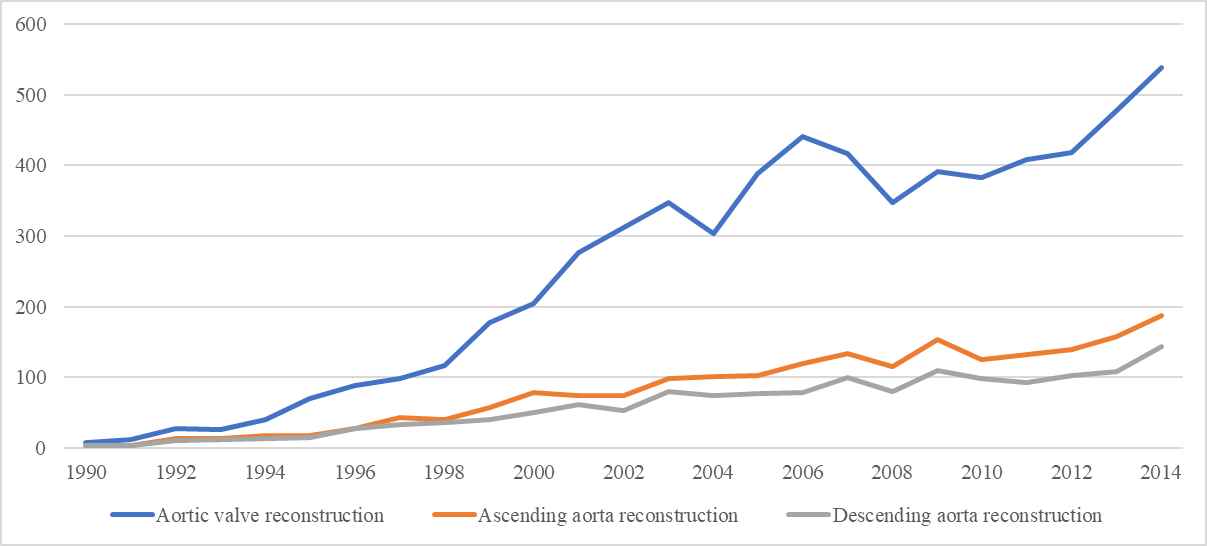
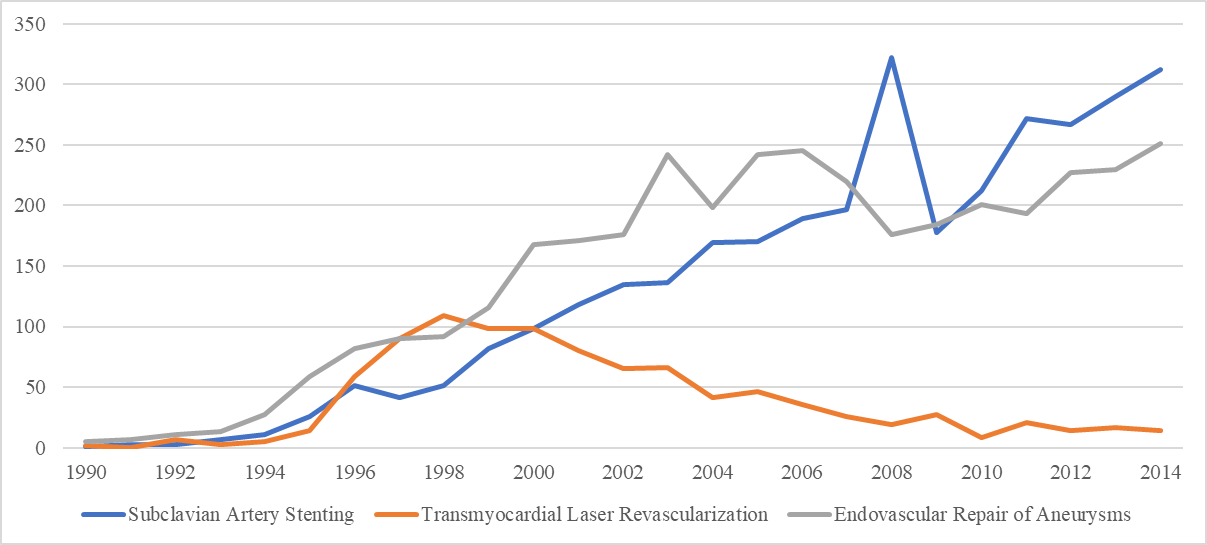
It is interesting to forecast the change of the demand for skills in the future. For this purpose, we propose a professional predictive learning approach, by which we mean learning the technologies and methods that will be in demand for a specified profession in the future. In other words, training ahead of the technology development.
The study analyzed 60 skills included in the training program of professional education courses. For the convenience of perception, the article lists 20 most representative ones. Also, for ease of perception, each of the skill is assigned with a skill code and skill group code (Table
Research Questions
-
What is the correlation between the demand for specialists in the labor market and the preceding patent activity?
-
What specialized software solutions might be needed for the analysis of patent activity for individual skills?
-
Which of the mentioned skills should be considered promising and demanded in the labor market?
Purpose of the Study
The purpose of this study is to analyze the possibility of assessing the demand for professional skills in the labor market using patent activity data and specialized software tools.
Research Methods
Studies in the field of patent activity and demand in the labor market are labor intensive. Some of the stages can be automated. The authors developed a professional predictive learning service (Nikulchev, Ilin, Bubnov, & Mateshuk, 2017) for decision support that collects, homogenizes and visualizes data. It uses open data on patent activity, data on labor market and other kinds of data.
The involved sources have a number of features:
The existence of homonyms that introduce noise into data.
The existence of differences in the writing of technology names (for example, the use of acronyms and abbreviations).
The first feature is characterized by the fact that the percentage of false-positive results in patent searches, as well as when searching in other sources of data (scientific publications, vacancy databases), can exceed reasonable boundaries. For example, as was noted during the search for vacancies (Nikulchev, Ilin, Mateshuk, 2017), in some cases the share of false-positive results can be more than 94%. Because of this, the study will use the contextual keywords filtering method (Ilin, Mateshuk, Gilaztdinov, & Bubnov, 2017). Table
To illustrate the second feature, we give an example from the field of marketing: Search Engine Optimization (SEO). This area of expertise is in demand in organizations engaged in the promotion of goods and services in search engines. The skill mentioning occurs in patents both in the form of a full name and in the form of an abbreviation (fig. 3), however, in the second case, there is a large percentage of extraneous documents among the patents (fig. 4). Employers' vacancies often use SEO abbreviation (fig. 5). Considering this, it is reasonable to use the full name for some sources (patent databases, scientific publication databases) and an abbreviation for others (Internet recruitment agencies).
To conduct studies that require different variations in the spelling of keywords for different data sources, the service has been upgraded with a new mechanism that provides this capability. Figure
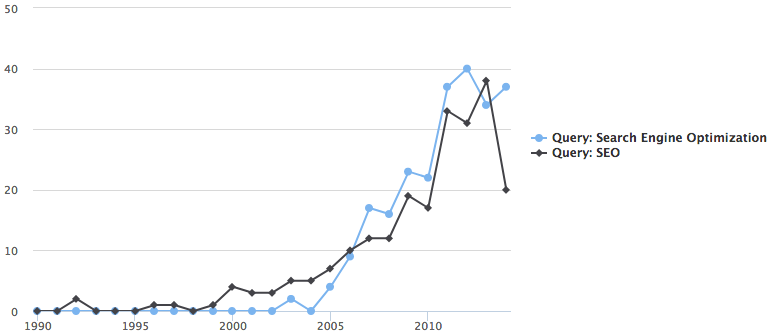
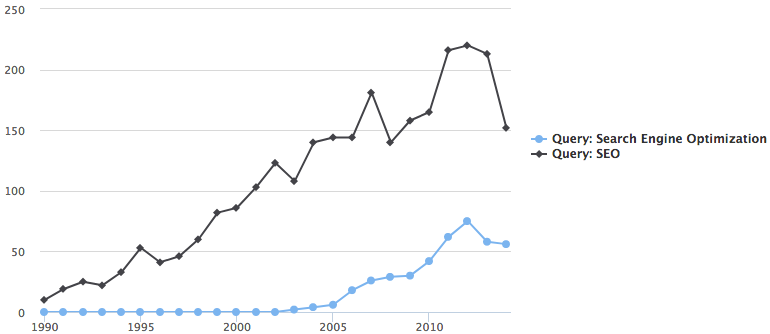
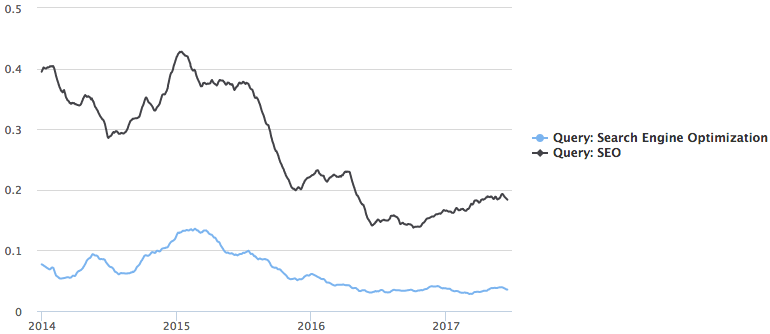
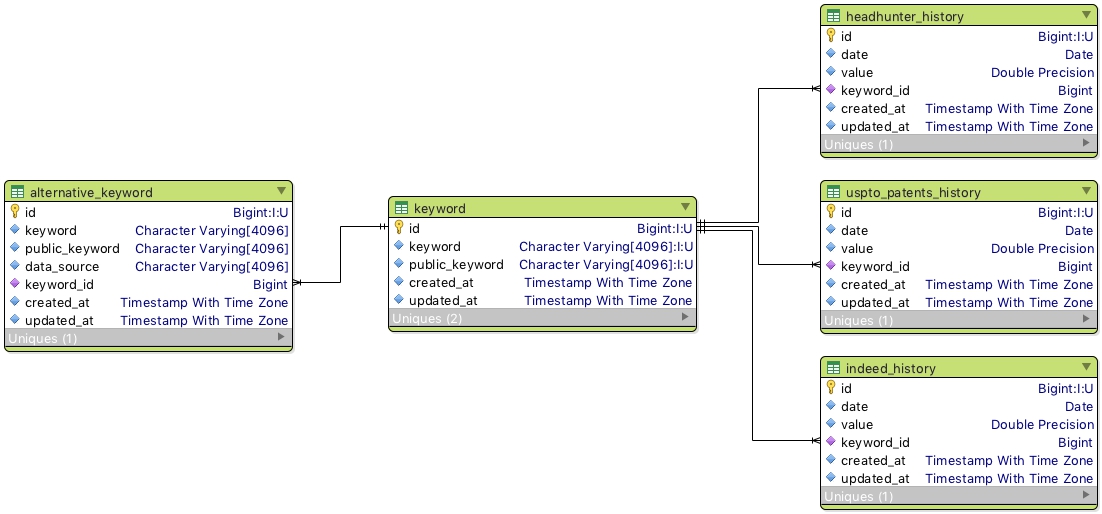
Findings
The collected data on patent activity (Table
The data on the skill S01 was normalized and represented as a percentage of the maximum number of patents per year. This is due to the specificity of the patent search in the USPTO service, which does not allow to identify patents related to the names consisting of a single letter or containing special symbols (which can be relevant for technologies such as C++ or C#).
To verify the compliance of the obtained data to the real state of the labor market, the vacancy shares in the labor market in the United States were collected. From these data, the mean values were calculated for the period from January 2014 to June 2017 (Table
The Pearson correlation coefficient was calculated for all of the skills except S01, as the data on patent activity for S01 was normalized and cannot be used for the evaluation (Table
Based on the results it is possible to say with confidence that the majority of the presented skills are appropriate for studying: they are either well-established or developing. An exception to this is FreeBSD Administration, as evidenced by both low rates of annual patent activity and the minimal labor market demand for specialists.
Conclusion
According to the results of the study, it can be said that the analysis of patent activity can be used not only to assess technology and forecast their development, but also to assess the relevance of the skills associated with them. Moreover, it is possible to assess the relevance of the methods related to operational skills. A strong correlation between the annual number of patents and vacancies in the labor market presents the possibility of forecasting of the demand for skills.
Mechanisms were implemented to apply the appropriate variants of the skills' names to use various data sources in the professional predictive learning service. A filtering mechanism based on contextual keywords for data from the USPTO service was implemented.
Using these mechanisms, 20 skills were analyzed. Programming languages C, Java and Python are popular and well established in the market, however C has some decrease in demand. Web development skills consist of well-established skills (HTML and CSS) and from relatively new ones which noticeably gaining in popularity (HTML5 and CSS3). Machine Learning is an established skill in the field of analytics, and the skills of Deep Learning and Big Data Analytics begin to occupy their market share. All mentioned skills from the field of marketing show a small and stable increase in demand. System administration skills are also in demand, except for the FreeBSD Administration skill.
The results of the work can be applied for conducting similar studies assessing the relevance of educational programs, as well as for the further development of software tools for professional predictive learning.
Acknowledgments
The work was carried out within the framework of the state task of the Ministry of Education and Science, project No. 25.10167.2017 / BC "Development of the technological concept of the data center of interdisciplinary research in education"
References
- Altuntas, S., Dereli, T., & Kusiak, A. (2015). Forecasting technology success based on patent data. Technological Forecasting and Social Change, 96, 202-214.
- Bird, J., van de Mortel, T., Holt, J., & Walo, M. (2015). Academics' perceptions of continuous and collaborative curriculum review: An Australian case study. Journal of Hospitality and Tourism Management, 24, 18-24.
- Brusilovsky, P., Edwards, S., Kumar, A., Malmi, L., Benotti, L., Buck, D., . . . Urquiza, J. (2014). Increasing adoption of smart learning content for computer science education. Proceedings of the Working Group Reports of the 2014 on Innovation & Technology in Computer Science Education Conference, (pp. 31-57).
- Crebert, G., Bates, M., Bell, B., Patrick, C.‐J., & Cragnolini, V. (2004). Developing generic skills at university, during work placement and in employment: graduates' perceptions. Higher Education Research & Development, 23(2), 147-165.
- Hagiu, A., & Yoffie, D. B. (2013). The new patent intermediaries: platforms, defensive aggregators, and super-aggregators. The Journal of Economic Perspectives, 27(1), 45-65.
- Konecki, M., & Petrlic, M. (2014). Main problems of programming novices and the right course of action. Central European Conference on Information and Intelligent Systems.
- Lee, C., Kim, J., Kwon, O., & Woo, H.-G. (2016). Stochastic technology life cycle analysis using multiple patent indicators. Technological Forecasting and Social Change, 106, 53-64.
- Neily, J., Mills, P. D., Young-Xu, Y., Carney, B. T., West, P., Berger, D. H., . . . Bagian, J. P. (2010). Association between implementation of a medical team training program and surgical mortality. Jama, 304(15), 1693-1700.
- Nikulchev E., Ilin, D. & Mateshuk, E. (2017). Scalable service for professional skills analysis based on the demand of the labor market and patent search. Procedia Computer Science, 103, 44-51.
- Nikulchev, E., Ilin, D., Bubnov, G., & Mateshuk, E. (2017). Scalable Service for Predictive Learning Based on the Professional Social Networking Sites. International Journal of Advanced Computer Science and Applications, 8(5), 9-15.
- Tynjälä, P., Slotte, V., Nieminen, J., Lonka, K., & Olkinuora, E. (2006). From university to working life: Graduates’ workplace skills in practice. Higher education and working life: Collaborations, confrontations and challenges, 73-88.
Copyright information

This work is licensed under a Creative Commons Attribution-NonCommercial-NoDerivatives 4.0 International License.
About this article
Publication Date
13 December 2017
Article Doi
eBook ISBN
978-1-80296-032-7
Publisher
Future Academy
Volume
33
Print ISBN (optional)
-
Edition Number
1st Edition
Pages
1-481
Subjects
Cognitive theory, educational equipment, educational technology, computer-aided learning (CAL), psycholinguistics
Cite this article as:
Nikulchev, E., Ilin, D., Bubnov, G., Osipov, I., & Kosenkov, A. (2017). Modernization Of Educational Programs Of Professional Skill Improvement Using Patent Activity Data. In S. B. Malykh, & E. V. Nikulchev (Eds.), Psychology and Education - ICPE 2017, vol 33. European Proceedings of Social and Behavioural Sciences (pp. 272-281). Future Academy. https://doi.org/10.15405/epsbs.2017.12.27

